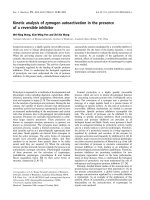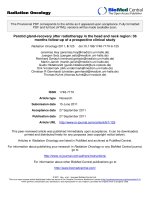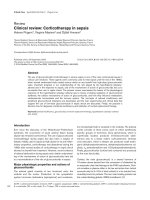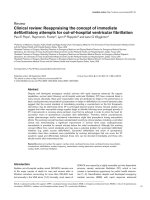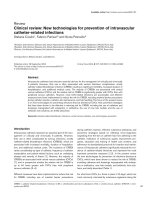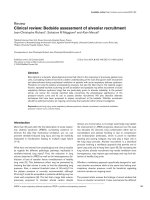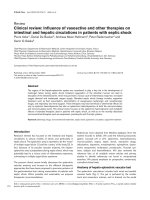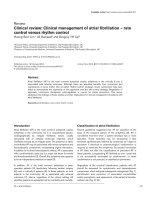Báo cáo khoa học: "Clinical review: Agitation and delirium in the critically ill – significance and management" ppt
Bạn đang xem bản rút gọn của tài liệu. Xem và tải ngay bản đầy đủ của tài liệu tại đây (378.68 KB, 5 trang )
Page 1 of 5
(page number not for citation purposes)
Available online />Abstract
Agitation is a psychomotor disturbance characterized by a marked
increase in motor and psychological activity in a patient. It occurs
very frequently in the intensive care setting. It may be isolated, or
accompanied by other mental disorders, such as severe anxiety
and delirium. Frequently, agitation is a sign of brain dysfunction
and, as such, may have adverse consequences, for at least two
reasons. First, agitation can interfere with the patient’s care and
second, there is evidence demonstrating that the prognosis of
agitated (and delirious) patients is worse than that of non-agitated
(non-delirious) patients. These conditions are often under-
diagnosed in the intensive care unit (ICU). Consequently, a
systematic evaluation of this problem in ICU patients should be
conducted. Excellent tools are presently available for this purpose.
Treatment, including prevention, must be undertaken without delay,
and the ICU physician should follow logical, strict and systematic
rules when applying therapy.
Introduction
Agitation is a psychomotor disturbance characterized by a
marked increase in both motor and psychological activities,
often accompanied by a loss of control of action and a
disorganization of thought. This problem is driven by
frequently occurring situations in the intensive care unit (ICU),
such as anxiety and delirium. Therefore, it is fairly common in
the ICU setting, particularly in older patients, and it may be
caused by numerous factors, linked both to the disease itself
(metabolic disorders, medications, sepsis-associated
encephalopathy, and so on) and to external factors (noise,
discomfort, pain, and so on) [1]. Agitation per se may be
dangerous in the ICU: its occurrence may compromise care,
raise metabolic requirements and, finally, increase morbidity
and mortality [2]. Length of stay in the ICU as well as in the
hospital may also be increased, in turn leading to an increase
in costs. In addition, compared to that of similar but non-
delirious patients, the post-hospital mortality rate may be
higher in patients having presented with agitation and
delirium. For all these reasons, these mental disorders should
be a source of serious concern and, therefore, vigorously
managed through a systematic approach [3]. It is generally
accepted that these symptoms represent a marker of acute
cerebral insufficiency.
Significance of agitation and delirium in the ICU
Besides agitation, several mental disturbances may be
observed in the ICU, in particular anxiety and delirium. It is not
presently known if these mental states express different types
of brain dysfunction, or if they represent some sort of
spectrum in the severity of the cerebral insult [1]. Anxiety is a
diffuse sensation of fear, which is not related to a real and
actual external danger. This sensation is expected to occur in
the ICU due to the numerous stressful situations occurring in
this setting (pain, noise, and loss of body control, among
others) [4]. If a certain degree of anxiety seems to be ‘normal’
in the ICU environment, some authors have described a
‘pathological’ anxiety when this sensation appears to be
disproportionately high considering its cause, and when it is
associated with other severe signs, such as severe dys-
autonomia, loss of self-control, and cannot be appropriately
treated due to a complete lack of patient cooperation [5].
Delirium is defined as an acute change in mental status, or a
fluctuation of mood, associated with impaired attention,
disorganized thinking, confusion and an altered level of
consciousness [5]. It is often referred to as a state of acute
confusion. Most cases of delirium have an acute onset,
particularly in the ICU. Typically, this cognitive alteration
varies throughout the day, and achieves peak intensity during
the night. This symptom is usually reversible within a period of
days or weeks, whereas some patients can progress to
permanent brain failure. Illusions and hallucinations may also
occur. Florid delirium with intense agitation in a combative
patient (active delirium) is easy to detect, but delirium can
also be present in a calm and quiet patient (hypoactive
delirium), the succession of both types being possible [6].
Despite the fact that this disturbance is frequent in the ICU
Review
Clinical review: Agitation and delirium in the critically ill –
significance and management
Jean-Claude Chevrolet and Philippe Jolliet
Hôpital Cantonal Universitaire, rue Micheli-du-Crest, CH 1211 Geneva 4, Switzerland
Corresponding author: Jean-Claude Chevrolet,
Published: 17 May 2007 Critical Care 2007, 11:214 (doi:10.1186/cc5787)
This article is online at />© 2007 BioMed Central Ltd
EEG = electroencephalogram; ICU = intensive care unit.
Page 2 of 5
(page number not for citation purposes)
Critical Care Vol 11 No 3 Chevrolet and Jolliet
(occurring in 15% to 40% of patients) [7,8], it seems that
critical care physicians’ performance in detecting it remains
poor; around two-thirds of these patients are not identified
[1,9]. Fortunately, simple tools that can be used by non-
psychiatrists at the bedside have been developed to detect
delirium in the ICU [10,11].
Many difficult but interesting questions regarding agitation
and delirium in the ICU remain unanswered. First, it is not
known precisely if the prevention [12] or the timely detection
and treatment of this condition can favorably influence a
patient’s outcome [13]. Second, the exact relationships
between agitation and delirium, on the one hand, and
mortality and cerebral dysfunction, on the other, are poorly
understood. In particular, it would be of great interest to
understand if the brain is just a passive victim, one of many
organs to dysfunction in critical illness, expressing its injury
through agitation and delirium, or if it is an active player,
participating and contributing to the extracerebral organ
dysfunction [14,15]. The indication and type of treatment for
agitation and delirium are clearly related to the answers to
these questions.
The exact mechanisms causing the mental problems
described above in ICU patients have not been fully
characterized, except when a metabolic cause is obvious,
such as hypoglycemia, or hypoxemia. Nevertheless, these
disturbances are believed to have an organic basis [16]. The
generalized electroencephalographic abnormalities observed
during this condition represent an argument in favor of such a
diffuse neurological dysfunction [17].
Several hypotheses are actively discussed today. First, the
role of abnormalities at the level of the central
neurotransmission process is debated; these abnormalities
are characterized by an excess in dopaminergic activity
consecutive with a depletion in cholinergic stores [18,19].
Importantly, many drugs prescribed in the ICU have an anti-
cholinergic activity and some of them have been clearly
associated with delirium, such as antiarrhythmic medications,
antibiotics (penicillin, rifampin), and so on. These drugs
should be avoided in delirious patients when possible.
Interestingly, an ‘inflammatory reflex’ has recently been
observed, leading to a real cooperation between the central
nervous system and the inflammatory pathways [20]. More
precisely, an anti-inflammatory action exerted by vagus nerve
endings located at the vicinity of macrophages in
inflammatory foci, through nicotinic receptors at the surface
of these cells, has been demonstrated [21]. These
observations could provide some explanation as to the origin
of delirium caused by a neuronal dysfunction, as well as a
substrate for the causal role of the brain in immunomodulation
[15]. Other central neurotransmitters have been thought to
play a role in delirium, such as dopamine [22], serotonin [23],
or gamma-aminobutyric acid (GABA) [16]. This probably
represents the substrate for the delirium occasionally
associated with benzodiazepines or propofol (so-called
‘paradoxical reactions’). Note also that benzodiazepines [24]
and opioids [25] have been clearly shown to be independent
factors for the occurrence of delirium.
The second group of hypotheses to explain the mental
dysfunction observed in the ICU relates to the presence of
potential organic cerebral lesions not detectable by currently
available technology (computed tomography (CT) scan,
magnetic resonance imaging, and so on) [26]. There are
clinical and epidemiological arguments in favor of these hypo-
theses. Thus, some patients who suffer a mental dysfunction
during their ICU stay never fully recover, whereas a rapid
decline in the cognitive function of others has been described
after an ICU stay during which delirium occurred [27,28]. It is
known that in severe sepsis, for instance, many organs are
affected by structural damage, particularly in the
microcirculation (microthromboses, endothelial swelling, and
so on). There is no a priori reason for the brain to be spared
by such damage.
Even if the causes of mental disturbance observed in the ICU
are poorly known, their consequences have been largely
described. Severe psychological sequellae have been
documented [29]. A dangerous increase in the metabolic
demand due to agitation may compromise already limited
myocardial or cerebral functions, and intracranial
hypertension may be worsened [3]. Finally, mortality and
overall morbidity may be increased by, for example, accidental
tracheal extubation, asynchrony with the ventilator, removal of
catheters in which vital medications are administered, and so
on [3,30], and hospital length of stay is also increased [31].
Management
Evaluation of mental disturbance in the ICU
Clinical evaluation
Before treating agitation, anxiety or delirium in the ICU, these
symptoms have to be closely scrutinized, and their diagnosis
firmly established. Firstly, the clinician needs to know about
the patient’s pre-existing mental state in order to establish
whether a link exists between the presently observed
condition and the disease that resulted in ICU admission.
Indeed, it is important to recall that around 30% to 40% of
ICU patients present with some degree of cognitive
impairment prior to their admission [32]. The second step is
to perform an objective assessment of the patient’s present
mental state. A non-standardized evaluation by a non-
psychiatrist is not recommended, especially as several
evaluation methods that have been validated in the ICU are
presently available; these methods can be used by ICU
physicians and nurses at the bedside, without being too time-
consuming [33]. The ‘reliability’ (consistency of the evaluation
when repeated over time) and the ‘validity’ (accuracy when
evaluating the patient’s mental state) of these measurements,
as well their ‘reactivity’ (ability to detect small changes in the
variable being studied) [34], are excellent [33]. Many scores
Page 3 of 5
(page number not for citation purposes)
for evaluating agitation, sedation and confusion in the ICU are
presently available [10,11,34-37].
However, all these scores suffer from the same conceptual
difficulty: each is constructed in a similar manner, that is, they
combine several clinical parameters and psychological
measurements into a continuous scale score. This approach,
while providing a reproducible and easy to use tool, also
carries the risk of lack of specificity regarding specific
aspects of mental alterations. Nonetheless, we are convinced
that, despite their weaknesses, it is important to measure
sedation, agitation and confusion in ICU patients with these
tools. This position finds support from recent data showing
that not only is caregiver compliance with their use excellent
in the ICU [38], but also that their use can improve the
management of agitated patients [39]. In addition, for
research purposes, an algorithm aimed at detecting delirium
has been recently developed [40].
Non-clinical investigations
EEGs (electroencephalograms) generally confirm the results
of clinical examinations, that is, that mental disorders
occurring in ICU patients are associated with a global brain
dysfunction. In addition, in some patients, particularly when
these disorders are associated with sepsis (sepsis
associated encephalopathy) [41], coma [17,42] or brain
damage [42], continuously recorded EEGs can detect
subclinical seizures or predict the occurrence of ischemic
brain lesions. However, no specific EEG recording in mental
disorders associated with the ICU has been performed, and
several technical concerns remain, particularly for continuous
EEG monitoring [43]. In addition, several issues remain
unanswered regarding continuous EEG recording in the ICU,
namely its exact indication, the required duration of
monitoring, and the clinical significance of certain tracing
patterns, such as periodic lateralized epileptiform discharges
(PLEDs) [44]. Therefore, the consequences of EEG
recording on treatment options and patient outcome remain
to be investigated in the ICU [45].
Simplified analysis of EEGs, such as bispectral analysis, has
been extensively studied in the operating room to assess the
depth of anesthesia. However, this technique seems difficult
to use in the ICU, even for assessing the degree of patient
arousal [46], and it is quite inappropriate for the evaluation of
mental disorders such as delirium, either because the patient
is agitated, or because of a lack of specificity in a non-
agitated delirious patient [47]. Other techniques, among
which evoked potentials, are not presently employed in the
routine monitoring of ICU patients suffering mental disorders
[48,49].
Treatment of ICU-associated mental disorders
As stated above, agitation, anxiety and delirium are frequent
in the ICU, but they are under-diagnosed, which in turn can
have adverse consequences on patient outcome [9].
Therefore, every effort should be undertaken to prevent and
treat these problems, even if there is to date no formal proof
of an improvement in mortality with treatment [1]. An
algorithm may help the clinician to conduct a systematic
approach to the management of agitation and delirium in the
ICU (Figure 1).
Non-pharmacological treatment must be considered first,
common sense and good clinical practice being the rule to
avoid light anxiety in ICU patients, for example, reassurance, a
comfortable position in the bed, voiding of a full and painful
bladder, and so on. Physical restraint can also be considered,
keeping in mind the ethical concerns regarding its use [50].
Physically restraining a patient should, therefore, never be
considered a trivial measure. It should in our view be the
result of a rational, systematic and documented (written)
approach, following an accepted algorithm. The patient’s
family should be given clear, complete and objective explana-
tions regarding treatment choices. Follow-up and monitoring
should follow a clear procedure to avoid complications (the
lethal strangulation of an ICU patient has even been
observed!), and the rationale for pursuing its application in a
given patient regularly discussed.
When simple measures are not sufficient to treat agitation, a
pharmacological approach must be undertaken. Beforehand,
a few simple principles should be remembered. First, before
undertaking a symptomatic treatment with drugs, every
potential cause of the mental disorder (hypoglycaemia,
hyponatremia, and so on) must have been corrected. Second,
it should be remembered that several drugs commonly
prescribed for agitation (such as benzodiazepines) may, by
themselves, cause or increase psychological or cognitive
disturbances. Third, the objectives of treatment (for example,
Available online />Figure 1
Assessment and management of delirium. BZD, benzodiazepine;
CAM-ICU, confusion assessment method for the intensive care unit
[32]; CT, computed tomography; DSM, Diagnostic and Statistical
Manual of Mental Disorders [5]; EEG, electroencephalogram; ICU,
intensive care unit; MRI, magnetic resonance imaging.
reducing pain, diminishing anxiety, inducing a better sleep
rhythmicity, treating delirium, and so on) must be clearly
defined in order to choose the appropriate drug. Fourth, the
level of sedation and the therapeutic goal when a delirious
patient is treated must be strictly adjusted and periodically
assessed by objective means (scores and scales) in order to
avoid the dangers of both under- and over-sedation.
An abundant literature is available on the treatment of
agitation and behavioral disturbances [51], but only a small
amount of information is specifically related to the ICU setting
[52,53]. Only a few classes of drugs have been sufficiently
evaluated in the ICU to be mentioned here, that is,
benzodiazepines, propofol and ketamine, as well as classic
and atypical neuroleptics. Myorelaxation must remain a rare
exception for treatment of behavioral disturbances. Only
patients with severe neurotrauma who require a strict control
of their movements as a result of intracranial hypertension or
vertebral instability, patients with unstable myocardial
ischemia before a coronary intervention, or some patients
with severe ARDS in whom mechanical ventilation proves
very difficult can be considered for a brief course of
myorelaxants. A simple approach is to first ensure adequate
pain control with opioids, and then treat anxiety with a
benzodiazepine, adding a neuroleptic drug if delirium is
present. It should be kept in mind that no controlled study is
presently available confirming the usefulness of administering
neuroleptics in the ICU setting [54]. However, haloperidol
remains largely used today in ICU patients, given its various
benefits: a rapid onset of action, a lowering of the epileptic
threshold (subclinical epileptic seizures are not rare in such
patients) and a possible favorable effect on the outcome of
patients with delirium, albeit this effect was suggested only in
a retrospective analysis [55]. However, many side-effects
have been reported with this medication, such as cardiac
arrhythmias, extrapyramidal symptoms, anticholinergic action,
and so on. To date, there has been no formal study on the
new atypical antipsychotic drugs in ICU patients, except for
olanzapine [56]. This drug may be useful in case of
contraindication or side-effects with haloperidol. Studies
should now focus on these drugs in the ICU setting, and one
study (MIND) is ongoing, comparing placebo, haloperidol and
ziprazidone [57].
Competing interests
The authors declare that they have no competing interests.
References
1. Pandharipande P, Jackson J, Ely E: Delirium: acute cognitive
dysfunction in the critically ill. Curr Opin Crit Care 2005, 11:
360-368.
2. Ely E, Shintani A, Truman B, Speroff T, Gordon S, Harrell F,
Inouye S, Bernard G, Dittus R: Delirium as a predictor of mor-
tality in mechanically ventilated patients in the intensive care
unit. JAMA 2004, 291:1753-1762.
3. Siegel M: Management of agitation in the intensive care unit.
Clin Chest Med 2003, 24:712-725.
4. Novaes M, Knobel B, Bork A, Pavao O, Nogueira-Martins L, Ferraz
M: Stressors in ICU: perception of the patient, relatives and
health care team. Intensive Care Med 1999, 25:1421-1426.
5. American Psychiatric Association: Diagnostic and Statistical
Manual of Mental Disorders. 4th edition (DSM IV). Washington,
DC: American Psychiatric Publishing; 1994.
6. Meagher D, Hanlon D, Mahony E: Relationship between symp-
toms and motoric subtypes of delirium. J Neuropsychiatry Clin
Neurosci 2000, 12:51-58.
7. Cohen I, Gallagher TJ, Pohlman AS, Dasta JF, Abraham E,
Papadokos PJ: Management of the agitated intensive care unit
patient. Crit Care Med 2002, 30:S97-S124.
8. Inouye S: The dilemma of delirium: clinical and research contro-
versies regarding diagnosis and evaluation of delirium of hos-
pitalized elderly medical patients. Am J Med 1994, 97:278-288.
9. Francis J, Martin D, Kapoor W: A prospective study of delirium
in hospitalized elderly. JAMA 1990, 263:1097-1101.
10. Bergeron N, Dubois M, Dumont M, Dial S, Skrobic Y: Intensive
care delirium screening checklist: evaluation of a new screen-
ing tool. Intensive Care Med 2001, 27:1432-1438.
11. Ely E, Margolin R, May L, Francis J, May L, Truman B, Dittus R,
Speroff T, Gautam S, Bernard G, Inouye S: Evaluation of delir-
ium in critically ill patients: validation of the Confusion
Assessment Method for the Intensive Care Unit (CAM-ICU).
Crit Care Med 2001, 29:1370-1379.
12. Inouye S, Bogardus S, Charpentier P, Leo-Summers L, Acampora
D, Holford T, Cooney LJ: A multicomponent intervention to
prevent delirium in hospitalized older patients. N Engl J Med
1999, 340:669-676.
13. Riker R, Fraser G: Einstein, quantum mechanics and delirium.
Crit Care Med 2005, 33:1421-1422.
14. Crippen D: Life-threatening brain failure and agitation in the
intensive care unit. Crit Care 2005, 4:81-90.
15. Sharshar T, Hopkinson N, Orlikowski D, Annane D: Science
review: The brain in sepsis - culprit and victim. Crit Care 2005,
9:37-44.
16. Milbrandt E, Angus D: Potential mechanisms and markers of
critical illness-associated cognitive dysfunction. Curr Opin Crit
Care 2005, 11:355-359.
17. Hirsch L: Continuous EEG monitoring in the intensive care
unit: an overview. J Clin Neurophysiol 2004, 21:332-340.
18. Flacker J, Wei J: Endogenous anticholinergic substances may
exist during acute illness in elderly medical patients. J Geron-
tol Am Biol Sci Med Sci 2001, 56:M353-M355.
19. Mussi C, Ferrari R, Ascari S, Salvioli G: Importance of serum
anticholinergic activity in the assessment of elderly patients
with delirium. J Geriatr Psychiatry Neurol 1999, 12:82-86.
20. Czura C, Tracey K: Autonomic neural regulation of immunity. J
Intern Med 2005, 257:156-166.
21. Borovikova L, Ivanova S, Zhang M, Yang H, Botchkina G, Watkins
L, Wang H, Abumrad N, Eaton J, Tracey K: Vagus nerve stimula-
tion attenuates the systemic inflammatory response to endo-
toxin. Nature 2000, 405:458-462.
22. Sommer B, Wise L, Kraemer H: Is dopamine administration
possibly a risk factor for delirium? Crit Care Med 2002, 30:
1508-1511.
23. Boyer E, Shannon M: The serotonin syndrome. N Engl J Med
2005, 352:1112-1120.
24. Pandharipande P: Lorazepam is an independent risk factor for
transitioning to delirium in intensive care unit patients. Anes-
thesiology 2006, 104:21-26.
25. Marcantonio E, Juarez G, Goldman L, Mangione C, Ludwig L, Lind
L, Katz N, Cook F, Orav J, Lee T: The relationship of postopera-
tive delirium with psychoactive medications. JAMA 1994, 272:
1518-1522.
26. Orlikowski D, Sharshar T, Annane D: The brain in sepsis. Adv
Sepsis 2003, 3:4-8.
27. Jackson J: The association between delirium and cognitive
decline: a review of the empirical litterature. Neuropsychol Rev
2004, 14:87-98.
28. Jackson J, Hart R, Gordon S, Shintani A, Truman B, May L, Ely E:
Six-month neuropsychological outcome of medical intensive
care unit patients. Crit Care Med 2003, 31:1226-1234.
29. Jones C, Griffith R, Humpris G: Memory, delusions, and the
development of of acute posttraumatic stress disorder-
related symptoms after intensive care. Crit Care Med 2001,
29:573-580.
30. Lorente L, Huidoboro M, Martin M, Jimenez A, Mora M: Accidental
catheter removal in critically ill patients: a prospective and
Critical Care Vol 11 No 3 Chevrolet and Jolliet
Page 4 of 5
(page number not for citation purposes)
observational study. Crit Care 2004, 8:R229-R233.
31. Thomason J, Shintani A, Peterson E, Pun B, Jackson J, Ely E:
Intensive care unit delirium is an independent predictor of
longer hospital stay: a prospective analysis of 261 non-venti-
lated patients. Crit Care 2005, 9:R375-R381.
32. Pisani M, Inouye S, McNicoll L, Redlich C: Screening for pre-
existing cognitive impairment in older intensive care patients.
J Am Geriatric Soc 2003, 51:591-598.
33. De Jonghe B, Cook D, Appere-De-Vecchi C, Guyatt GH, Mead M,
Outin H: Using and understanding sedation scoring systems:
a systematic review. Intensive Care Med 2000, 26:275-285.
34. De Jonghe B, Cook D, Griffith R, Appere-de-Vecchi C, Guyatt
GH, Théron V, Vagnerre V, Outin H: Adaptation to the intensive
care environment (ATICE): development and validation of a
new sedation assessment instrument. Crit Care Med 2003, 31:
2344-2354.
35. Ely E, Inouye S, Bernard G, Gordon S, Francis J, May L, Truman
B, Speroff T, Gautam S, Margolin R, et al.: Delirium in mechani-
cally ventilated patients: validity and reliability of the confu-
sion assessment method for the intensive care unit
(CAM-ICU). JAMA 2001, 286:2703-2710.
36. Devlin J, Boleski G, Mlynarek M, Mark R, Nerenz D, Peterson E,
Jankowski M, Horst H, Zarowitz B: Motor activity assessment
scale: a valid and reliable sedation scale for use with mechan-
ical ventilated patients in an adult surgical intensive care unit.
Crit Care Med 1999, 27:1271-1275.
37. Riker R, Picard J, Fraser G: Prospective evaluation of the Seda-
tion-Agitation Scale (SAS) for adult critically ill patients. Crit
Care Med 1999, 27:1325-1329.
38. Truman B, Gordon S, Peterson J, Shintani A, Jackson J, Foss J,
Harding S, Bernard G, Dittus R, Ely E: Large-scale implementa-
tion of sedation and delirium monitoring in the intensive care
unit: a report from two medical centers. Crit Care Med 2005,
33:1199-1205.
39. Micek S, Anand N, Laible B, Shannon W, Kollef M: Delirium as
detected by the CAM-ICU predicts restraint use among
mechanically ventilated patients. Crit Care Med 2005, 33:
1260-1265.
40. Pisani M, Araujo K, Van Ness P, Zhang Y, Ely E, Inouye S: A
research algorithm to improve detection of delirium in the
intensive care unit. Crit Care 2006, 10:R121-R129.
41. Consales G, de Gaudio A: Sepsis assopciated encephalopa-
thy. Minerva Anestesiol 2005, 71:39-52.
42. Claassen J, Mayer S, Hirsch L: Continuous EEG monitoring in
patients with subarachnoid hemorrhage. J Clin Neurophysiol
2005, 16:92-98.
43. Jordan K: Continuous EEG monitoring in the neuroscience
intensive care unit and emergency department. J Clin Neuro-
physiol 1999, 19:14-39.
44. Chong D, Hirsch L: Which EEG patterns warrant treatment in
the critically ill ? Reviewing the evidence for treatment of peri-
odic epileptiform discharges and related patterns. J Clin Neu-
rophysiol 2005, 22:79-91.
45. Hirsch L, Brenner R, Drislane F, So E, Kaplan P, Jordan K, Herman
S, LaRoche S, Young B, Bleck T, et al.: The ACNS subcommit-
tee on research terminology for continuous EEG monitoring:
proposed standardized terminology for rythmic and periodic
EEG patterns encountered in critically ill patients. J Clin Neu-
rophysiol 2005, 22:128-135.
46. Nasraway S, Wu E, Kelleher R, Yasuda C, Donnelly A: How reli-
able is the bispectral index in critically ill patients ? A
prospective, comparative, single-blinded observer study. Crit
Care Med 2002, 30:1483-1487.
47. Ely E, Truman B, Manzi D, Sigl J, Shintani A, Bernard G: Con-
sciousness monitoring in ventilated patients: bispectral EEG
monitors arousal, not delirium. Intensive Care Med 2004, 30:
1537-1543.
48. Schulte-Tamburen A, Scheier J, Briegel J, Schwender D, Peter K:
Comparison of five sedation scoring systems by means of
auditory evoked potentials. Intensive Care Med 1999, 25:350-
352.
49. Zauner C, Gendo A, Kramer L, Funk G, Bauer E, Schenk P,
Raatheiser K, Madl C: Impaired subcortical and cortical
sensory evoked potential pathways in septic patients. Crit
Care Med 2002, 30:1136-1139.
50. Maccioli G, Dorman T, Brown B, Mazuski J, McLean B, Kuszaij J,
Rosenbaum S, Frankel L, Devlin J, Govert J, et al.: Clinical prac-
tice guidelines for the maintenance of patient physical safety
in intensive care unit: use of retraining therapies - American
College of Critical Care Medicine Task Force 2001-2002. Crit
Care Med 2003, 31:2665-2676.
51. Battaglia J: Pharmacological management of acute agitation.
Drugs 2005, 65:1207-1222.
52. Walder B, Tramèr M: Analgesia and sedation in critically ill
patients. Swiss Med Wkly 2004, 134:333-336.
53. Jacobi J, Fraser G, Coursin D, Riker R, Fontaine D, Wittbrodt E,
Chalfin D, Masica M, Bjerke H, Coplin W, et al.: Clinical practice
guidelines for the sustained use of sedatives and analgesics
in the critically ill adult, developed through the Task Froce of
the American College of Critical Care Medicine (ACCM) of the
Society of Critical Care Medicine (SCCM) in collaboration with
the American Society of Health-System Pharmacists (ASHP),
and in alliance with the American College of Chest Physi-
cians, and approved by the Board of Regents of ACCM, and
the Council of SCCM and the ASHP Board of Directors. Crit
Care Med 2002, 30:119-141.
54. Battaglia J, Moss S, Rush J, Leedom L, Dubin W, McGlynn C,
Goodman L: Haloperidol, lorazepam, or both for psychotic agi-
tation ? A multicenter, prospective, double-blind, emergency
department study. Am J Emerg Med 1997, 15:335-340.
55. Milbrandt E, Kersten A, Kong L, Weissfeld L, Clermont G, Fink M,
Angus DC: Haloperidol use is associated with lower hospital
mortality in mechanically ventilated patients. Crit Care Med
2005, 33:226-229.
56. Skrobic Y, Bergeron N, Dumont M, Gottfried S: Olanzapine vs.
haloperidol: treating delirium in a critical care setting. Inten-
sive Care Med 2004, 30:444-449.
57. Ely E: The MIND Study [ />NCT00096863;jessionid=D25B155CB67EEA3F8C98F5D6B67
C9F1B?order=2]
Available online />Page 5 of 5
(page number not for citation purposes)
